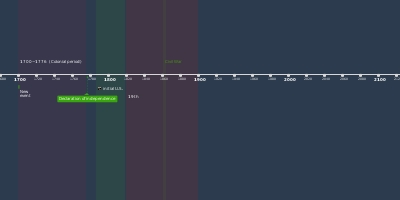19th (1 jan 1820 ano – 1 jan 1900 ano)
Descrição:
The United States was pre-industrial throughout the first third of the 19th century. Most people lived on farms and produced much of what they consumed. A considerable percentage of the non-farm population was engaged in handling goods for export. The country was an exporter of agricultural products. The U.S. built the best ships in the world.The textile industry became established in New England, where there was abundant water power. Steam power began being used in factories, but the water was the dominant source of industrial power until the Civil War.
The building of roads and canals, the introduction of steamboats, and the first railroads were the beginning of a transportation revolution that would accelerate throughout the century.
- Andrew Jackson -
President Andrew Jackson (1829–1837), leader of the new Democratic Party, opposed the Second Bank of the United States, which he believed favored the entrenched interests of rich. When he was elected for a second term, Jackson blocked the renewal of the bank's charter. Jackson opposed paper money and demanded the government be paid in gold and silver coins. The Panic of 1837 stopped business growth for three years.
- Population Growth -
Although there was relatively little immigration from Europe, the rapid expansion of settlements to the West, and the Louisiana Purchase of 1803, opened up vast frontier lands. The high birth rate, and the availability of cheap land caused the rapid expansion of population. The average age was under 20, with children everywhere. The population grew from 5.3 million people in 1800, living on 865,000 square miles of land to 9.6 million in 1820 on 1,749,000 square miles. By 1840, the population had reached 17,069,000 on the same land
- Labor shortage -
The U.S. economy of the early 19th century was characterized by labor shortages, as noted by numerous contemporary observers. The labor shortage was attributed to the cheapness of land and the high returns on agriculture. All types of labor were in high demand, especially unskilled labor and experienced factory workers. Labor prices in the U.S. were typically between 30 and 50 percent higher than in Britain. Women factory workers were especially scarce. The elasticity of labor was low in part because of lack of transportation and low population density. The relative labor scarcity and high price was an incentive for capital investment, particularly in machinery.
- Agriculture -
The U.S. economy was primarily agricultural in the early 19th century. Westward expansion plus the building of canals and the introduction of steamboats opened up new areas for agriculture. Much land was cleared and put into growing cotton in the Mississippi valley and in Alabama, and new grain growing areas were brought into production in the Midwest. Eventually this put severe downward pressure on prices, particularly of cotton, first from 1820 to 1823 and again from 1840 to 1843.
Adicionado na linha do tempo:
Data:
1 jan 1820 ano
1 jan 1900 ano
~ 80 years
